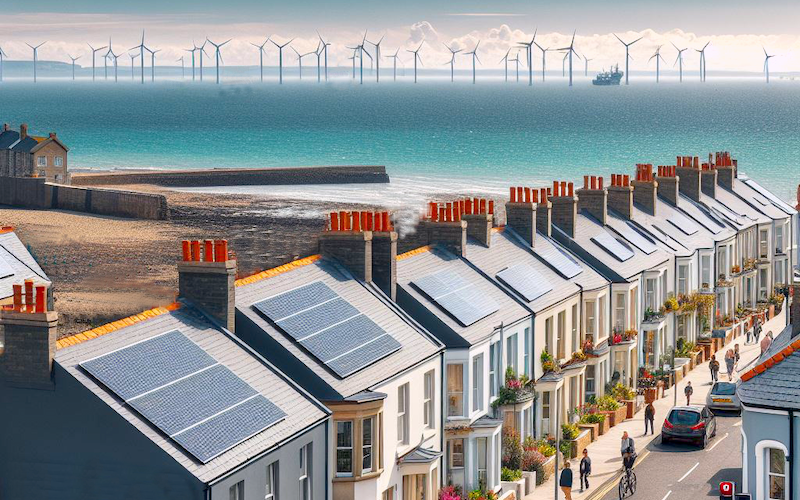Net zero energy system designs for the UK
A range of net zero emission renewable energy system analyses and designs for the UK produced by the EnergySpaceTime group.

18 January 2024
Green Light (GL) 2023
In the Green Light study (GL), Mark Barrett develops eleven 2050 net zero system designs with variations of climate change, demands, efficiency, heating shares and renewable generation. GL uses a model (ETSimpleMo) of the UK without interconnector trading. An algorithm operates the system hour by hour. The system capital and operational costs are calculated, and optimisation applied to find least cost designs. The transition of capacities, operation and costs between 2020 and 2050 is modelled.
GL explores how energy service demands might evolve with climate change, particularly reduced heating and increased cooling in buildings and vehicles, and how these demands can be electrified using renewables. Much electrification is direct, using electricity in heat pumps and vehicles and other equipment, but some is via electrofuels including hydrogen for industry and ammonia for ships. Reversible heat pumps are selected as a resilient adaptation option to provide heat and cool. District heat with heat storage is deployed. Hydrogen for heating is found to be uncompetitive. Aviation requires a hydrocarbon fuel and causes high altitude warming. In GL, some biowaste is available for fuel, but most is fossil kerosene. Aviation is the main residual emitter and it requires balancing negative emissions, provided here with 20 GWe of direct air capture with carbon sequestration (DACCS) running on surplus renewables. Even assuming the historic growth rate is halved, aviation fuel and emission balancing constitute about 20% of future energy system costs. An assessment of synthesising kerosene from atmospheric CO2 and electrolytic hydrogen is made.
Demands vary with social use patterns and meteorology, which latter also drives renewable generation. The GL electricity demand of around 800 TWh is mainly met with offshore wind (80%), onshore wind (4%) and solar (10%). Nuclear is uncompetitive and is restricted to Hinkley Point C. No biomass apart from waste is used, and this is allocated to aviation and residual generation. A mix of about 20 TWh of electricity, fuel and heat storage is used to supply services when renewables are in deficit. It is found optimal to spill 20-30% of potential renewable generation rather than build more storage or demand capacity. The 2050 GL designs cost about the same as the current UK energy system, with 90% of costs being fixed capital and operational costs, and the main fuel cost being for aviation. Thus consumers, apart from those who fly, would be almost invulnerable to fuel price spikes and import vulnerability caused by politics or disasters.
Long Term Storage (LTS) 2023
The Long Term Storage (LTS) report (Barrett, Gallo Cassarino, Sharp) was written at the request of the Royal Society for its report on large-scale electricity storage (The Royal Society, 2023). LTS used meteorology data for1980 to 2010 to simulate demands, and renewable generation. Total electricity demand averages about 700 TWh. A minimum of about 65 TWh of 100% efficient storage is required if all potential renewable generation is used, but if some potential generation is spilled (unused) then less storage is needed. Please see the publication for The Royal Society, 2023, Large-scale electricity storage. https://royalsociety.org/-/media/policy/projects/large-scale-electricity-storage/Large-scale-electricity-storage-report.pdf
Zero emission heating with renewables and interconnectors using ESTIMO
Gallo Cassarino, Barrett and Sharp developed a model called ESTIMO (energy space time integrated model and optimiser), which simulates hourly the energy systems of the UK and four European regions and interconnector trade between them, and calculates costs. This modelling showed trading could reduce storage needs by about 30%. Read more about the project:
- Gallo Cassarino, T. and Barrett, M. A. (2021) ‘Meeting UK heat demands in zero emission renewable energy systems using storage and interconnectors’, Applied Energy. Elsevier Ltd, 306(PB), p. 118051. doi: 10.1016/j.apenergy.2021.118051.
- Gallo Cassarino, T., Sharp, E. and Barrett, M. (2018) ‘The impact of social and weather drivers on the historical electricity demand in Europe’, Applied Energy, 229. doi: 10.1016/j.apenergy.2018.07.108.
Integrating district heating in renewable systems
District heating with heat pumps can use thermal storage to schedule some heat pump operation to times when renewables are in surplus and thereby reduce system costs.
- Siddiqui, S., Barrett, M. and Macadam, J. (2021) ‘A high resolution spatiotemporal urban heat load model for GB, Energies, 14(14). doi: 10.3390/en14144078.
- Siddiqui, S., Macadam, J. and Barrett, M. (2021) ‘The operation of district heating with heat pumps and thermal energy storage in a zero-emission scenario’, Energy Reports. Elsevier Ltd, 7, pp. 176–183. doi: 10.1016/j.egyr.2021.08.157.
Electricity pricing
A challenge is to construct an electricity market for a renewable system comprising mainly fixed capital and operational costs, and to estimate marginal costs or prices. John Macadam developed a pricing algebra which covered generation and storage, which was modelled by Salman Siddiqui. Read more about the project:
- Siddiqui, S., Macadam, J. and Barrett, M. (2020) ‘A novel method for forecasting electricity prices in a system with variable renewables and grid storage’, International Journal of Sustainable Energy Planning and Management, 27(Special Issue), pp. 51–66. doi: 10.5278/ijsepm.3497.
Land use of net zero scenarios 2023
Mark Barrett and Daniel Scamman assessed the land use requirements of net zero scenarios in a report to the CPRE. One finding is that all required PV capacity can be accommodated on rooftops and car parks.
Discussion
A primary aim is to show that renewable systems can reliably meet demands hour by hour in all meteorological conditions, and to find least cost designs. The work pointed to topics that would benefit from further research, including:
- interconnector trading
- renewable aviation fuel production
- the implementation of dynamic operational and investment strategies in social markets
- modelling of policies affecting consumer behaviour and supply chains to reach emissions targets
- Analysis of environmental impacts such as land use, waste, and materials
Links
- Learn more about the work of Mark Barrett - access this internal webpage.
Image credit: Mark Barrett, created with Image Creator
 Close
Close

